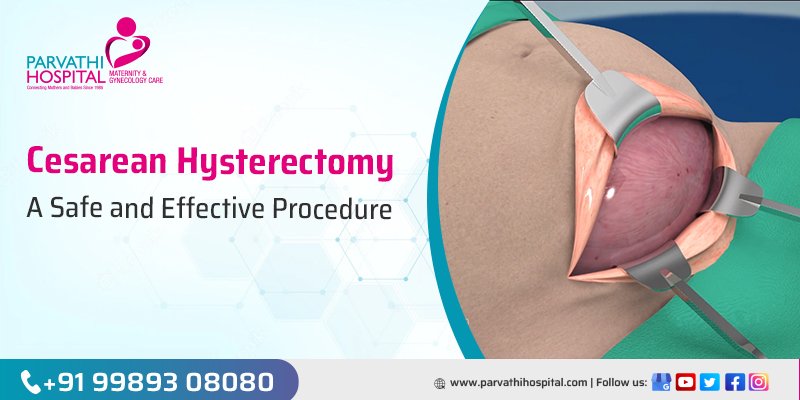Safe and Effective Procedure for Cesarean Hysterectomy

The uterus is removed during a cesarean delivery, which is referred to as a cesarean hysterectomy. Due to the anatomical and physiological changes of pregnancy, notably the large increase in blood flow to the uterus at term, it is a technically difficult surgery. The surgery is dramatic because it permanently terminates future fertility and is usually carried out in an emergency, unforeseen situations when a mother’s life is in peril. Visit Parvathi hospital, one of the most renowned maternity hospitals in Hyderabad for more details.
When is Cesarean Hysterotomy Done?
A hysterectomy after a cesarean delivery is typically only carried out when all other conservative treatment options have failed. Most of the time, it happens unexpectedly and is usually done as an emergency surgery to preserve the mother’s life. The following circumstances are typically indications for a cesarean hysterectomy:
1. Abnormal Placentation
The most frequent reason for undergoing a Cesarean hysterectomy is abnormal placentation. The placenta cannot separate from the underlying uterine tissue when this problem exists. Placentae accrete, placenta increta and placenta percreta are three different kinds of aberrant placentation that have been reported. Prior uterine surgeries and prior Cesarean deliveries are risk factors for aberrant placentation. Atypical placentation may be identified before delivery using MRI or ultrasonography, or it may be suspected based on a history of risk factors. Still, it can also be discovered unintentionally during delivery.
2. Tumors on the Uterus or Cervix
Cancerous or sizable non-cancerous uterine or cervix tumors may require a cesarean hysterectomy in women who have received this diagnosis after becoming pregnant. A hysterectomy can prevent cancer from spreading further. Women who don’t wish to have children in the future should prefer this. Along with surgery, other therapies like radiotherapy and chemotherapy might be needed.
3. Postpartum Hemorrhage
Bleeding after giving birth typically happens when the uterus’s muscular layer cannot contract. Uterine atony is another name for this inability of the uterus to contract. Before performing a hysterectomy, the surgeon may try several drugs and less invasive treatments, such as balloon tamponade, uterine artery or blood vessel tying on both sides or compression sutures, to reduce bleeding.
Risks Associated with Cesarean Hysterotomy:
1. Bleeding
The typical blood loss after labor is 2-3 liters, significantly more than usual. Multiple transfusions are needed in over half of placenta accreta spectrum patients. If you don’t want a blood transfusion for personal or religious reasons, you must tell your surgeon before the caesarean hysterectomy steps.
2. Damage to the Ureters, Intestines, and Bladder
Up to 50% of cases with placenta accreta invasion result in bladder damage. Injury to the bowel and ureter is less frequent. Ideally, any organ damage will be addressed while you are having surgery.
3. Infection:
Fever, redness, swelling, or pain are possible symptoms of infection. Maintain good hand hygiene and refrain from touching your bandage or wound. Every day, wash the incision with water and check it for any signs of infection, such as warmth, swelling, or redness. You might require medications and/or other procedures to ensure a speedy recovery if an infection develops.
4. Scar Tissue:
As part of routine healing, tissue thicker than normal skin develops. Some people are more prone than others to having denser scar tissue. How scar tissue develops within the body is unpredictable, but it can impact long-term health.
5. Colon Obstruction:
A blockage in the colon results in nausea, vomiting, bloating, and/or abdominal pain. This syndrome may be brought on by anesthesia, surgery, and painkillers. It usually gets better with time, patience, and restricting food intake until the bowels move. Occasionally, a tube may be placed into the stomach to drain fluids and gas while the patient receives hydration through an IV until the bowels start moving.
How to Prepare for the Surgery?
- Plan for a friend or family member to assist you with daily tasks for a few days after surgery. In 4-6 weeks, most women recover and resume most activities.
- Tell your doctor about all your prescription and non-prescription medications and any dietary supplements you take. You might need to change some of your medicines to accommodate your operation.
- Give up smoking. Smoking might hinder your recovery after surgery. Smokers tend to recuperate more slowly after surgery and may have respiratory issues. It is preferable to stop smoking 6 to 8 weeks before surgery if you smoke. You can get materials to help you quit smoking from your doctor or nurse. If you can’t quit smoking before surgery, your doctor can send a nicotine patch to the hospital for you. There are no smoking areas in the hospital.
- Breast feeding after cesarean hysterectomy can be tough, discuss some viable alternatives with your doctor to feed your baby until you recover.
Activities You Can and Cannot do post-surgery:
- Energy level: It’s typical to feel less energized following surgery. Refrain from engaging in any vigorous exercise during the first week at home. You’ll start to feel better as you get back into a routine at home. You can quickly regain your normal energy level by moving around the house and going for little walks.
- Showers: Showers are permitted after your clothing has been taken off. You may wear pads or pantyliners; however, tampons must not be used. The use of internal cleansing products such as vaginal douching is prohibited.
- Climbing: Stair climbing is permitted; however, you might need some assistance initially.
- Lifting: Do not lift anything heavier than a gallon of milk for the first few weeks. This includes pushing things, like a vacuum cleaner, and engaging in strenuous activity.
- Driving: Driving is unsafe during the first few weeks following surgery since you might be unable to make quick movements due to post-operative discomfort. Because pharmaceutical painkillers can make you sleepy, don’t drive while taking them.
- Exercise: Maintaining a healthy lifestyle requires practice. After surgery, you can resume your regular physical activity. Start with small strolls and gradually increase your walking time and distance. After surgery, wait 4-6 weeks before starting a more demanding fitness program to give the body time to heal.
- Intercourse: No sexual activity for 6 to 8 weeks following cesarean hysterectomy surgery recovery unless your doctor gives the all-clear.
Final Words:
Your scheduled postoperative appointment is crucial. It should be planned for 4-6 weeks following surgery. When you are released from the hospital, please phone your doctor’s office to make an appointment if you do not already have one. About six weeks after your operation, one of your medical professionals will contact you to discuss your overall experience.









